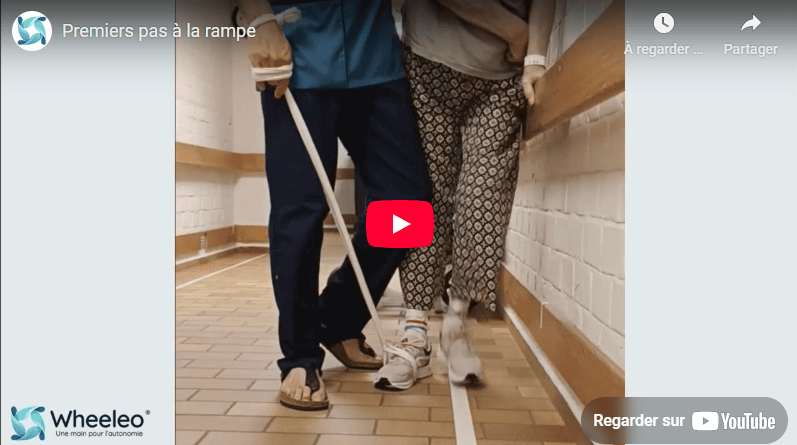
At the William Lennox Neurological Hospital Center, gait rehabilitation for hemiplegic patients often begins with training at the handrail, accompanied by a visual guide drawn on the floor approximately 20 cm from the wall. This simple but effective method offers numerous advantages for patient stability and safety.
The handrail provides a solid fixed point for the patient to lean on, thus reinforcing confidence and safety. The wall also acts as a vertical reference, limiting the risk of lateropulsion (lateral tilting of the body) and offering natural support. The line drawn on the floor allows precise positioning of the foot at an appropriate distance from the wall, preventing the “unaffected” foot from being too close, which would worsen lateropulsion.
By placing the foot on the line and the shoulder against the wall, the patient adopts a more stable posture with the center of gravity aligned above the support. This concrete instruction is often easier to apply than the vague command to “stand straight”.
In this context, it is possible to have a patient walk for several dozen meters even if they do not yet have sufficient voluntary motor control. The therapist assists the movement by helping to advance the leg, often by gently pushing behind the thigh with their knee, and using a Velpeau bandage® to guide foot placement. This assistance promotes intensive repetition of steps, a key factor in rehabilitation.
The goal is to maximize the number of steps taken during each session to stimulate the “intensity of the work and promote” autonomy. At the same time, it is crucial to ensure optimal gait quality to avoid harmful compensations (negative plasticity).
Unlike the handrail, parallel bars are not ideal for several reasons: they can generate a fear of open spaces that increases lateropulsion, they limit the available space for the therapist, and their length is often insufficient for sufficiently long walking courses.
This initial phase of rehabilitation at the handrail is generally characterized by a three-step gait, with very secure support but a slow and not very natural rhythm.
The next phase involves introducing a one-handed walker, such as the Wheeleo®. This innovative tool allows for a transition to a two-step gait, which is more fluid, faster, and closer to a normal walking pattern.
The Wheeleo® offers constant support even during movement, facilitating step reorganization, improving symmetry, and increasing cadence. The patient can thus gain confidence and autonomy, with a more natural gait pattern.
Gait rehabilitation for hemiplegic patients requires methodical progression, adapted to their current abilities. The handrail with a floor guide is an essential first step for learning posture and foot placement in a secure environment. Subsequently, using an innovative walker like the Wheeleo® allows for optimizing the resumption of a fluid, symmetrical gait that is closer to normal.
Each stage must be adjusted according to the patient’s needs and progress, always aiming for quality of movement and functional autonomy.
Please fill in this short form so that we can contact you to arrange a test.